 W
WBangladesh is a country with thousands of rivers and ponds and is notable for being a fish-loving nation, acquiring the name "Machh-e Bhat-e Bangali" which means, "Bengali by fish and rice".
 W
WAnguilla bengalensis bengalensis, the Indian mottled eel, is a subspecies of eel in the genus Anguilla of the family Anguillidae. It is found throughout the Indian subcontinent and neighbouring regions including the East Indies.
 W
WBagarius is an Asian genus of catfishes of the family Sisoridae. It includes four extant species,, and one extinct species, B. gigas.
 W
WBagarius yarrelli, also known as the giant devil catfish or goonch, is a very large species of catfish in the genus Bagarius found in rivers in the Indian subcontinent. It is possibly also found in Southeast Asia, but this may involve a separate species.
 W
WBalantiocheilos is a small genus of cyprinid fish from southeast Asia. It includes two species.
 W
WBangana ariza, the Reba or ariza labeo, is a cyprinid fish found in India, Nepal, Bangladesh, Afghanistan, and Pakistan.
 W
WBatasio is a genus of catfish of the family Bagridae. These small fish are found in fast-flowing hillstreams throughout South and mainland Southeast Asia.
 W
WDanio is a genus of small freshwater fish in the family Cyprinidae found in South and Southeast Asia, commonly kept in aquaria. They are generally characterised by a pattern of horizontal stripes, rows of spots or vertical bars. Some species have two pairs of long barbels. Species of this genus consume various small aquatic insects, crustaceans and worms.
 W
WErethistes is a genus of South Asian river catfishes.
 W
WErethistidae are a family of catfishes that originate from southern Asia. It includes about 26 species.
 W
WGagata is a genus of sisorid catfishes native to Asia.
 W
WThe Gangetic whiting, Sillaginopsis panijus, is a species of inshore marine and estuarine fish of the smelt-whiting family, Sillaginidae. It is the most distinctive Asian member of the family due to its flattened head and trailing dorsal fins. Although first described in 1822, it was not placed in its own genus until 1861 when Theodore Gill erected Sillaginopsis, a genus which is still monotypic. Gangetic whiting are of minor commercial importance along the Southeast coast of the Asian continent where it inhabits protected areas.
 W
WThe dwarf gourami is a species of gourami native to South Asia.
 W
WThe green chromide is a species of cichlid fish that is native to fresh and brackish water habitats in southern India and Sri Lanka. The species was first described by Marcus Elieser Bloch in 1790. Other common names include pearlspot cichlid, banded pearlspot, and striped chromide. In Kerala in India it is known locally as the karimeen. In Goa the fish is known as kalundar In Sri Lanka this fish is known as koraliya (කොරළියා).
 W
WHeteropneustes, the airsac catfishes, is a genus of catfishes native to Asia. This genus is the only one in its family.
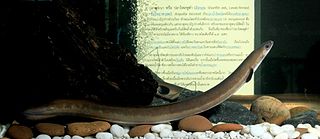 W
WThe Indonesian shortfin eel, Anguilla bicolor bicolor, is a subspecies of eel in the genus Anguilla of the family Anguillidae. It is found throughout the tropical coastal regions of the Indian Ocean and Western Pacific Ocean.
 W
WKetengus typus, the bigmouth sea-catfish, is the only species in the sea catfish genus Ketengus.
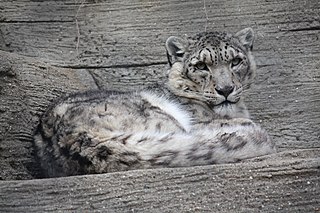 W
WThere are 531 species of Fish in Pakistan. 233 of them are of fresh water. Mahseer is Most of time this fish came to the city's Walter such as drains and also in the river and lakes the national fish of Pakistan. Here is a list of these fishes;Notopterus notoperus Notopterus chitala Naziritor zhobensis Triplophysa stoliczkai - Deosai only Diptyichus maculatus - Deosai only Ptychobarbus conirostis - Deosai only
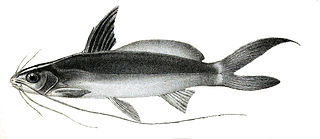 W
WMystus cavasius, the Gangetic mystus, is a species of catfish of the family Bagridae.
 W
WMystus gulio, the Long Whiskers Catfish, is a species of catfish of the family Bagridae. The generic name is probably derived from the Latin "mystax", meaning "moustache", due to the long barbels.
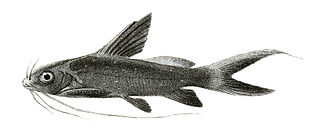 W
WMystus leucophasis is an Asian species of upside-down catfish belonging to the family Bagridae.
 W
WMystus nigriceps, the two-spot catfish, is a species of catfish of the family Bagridae. The species was available in aquarium circles without a scientific name until a connection was made to a description of Mystus micracanthus by the ichthyologist Bleeker, in 1846. The artist's impression at that time showed a catfish without any obvious markings, although another researcher in the early 1940s described it with two body spots. M. micracanthus is a junior synonym of M. nigriceps.
 W
WMystus vittatus, the striped dwarf catfish, is a species of catfish of the family Bagridae. It is found in brackish water systems with marginal vegetation in lakes and swamps with a mud substrate of Asian countries Pakistan, India, Sri Lanka, Nepal, Bangladesh and probably Myanmar. Populations of Southeast Asian countries is in debate, due to close morphological similarities among Mystus species in that region.
 W
WOlyra is a genus of catfishes of the family Bagridae. This genus occurs throughout South Asia and western Indochina, from India to western Thailand.
 W
WPeriophthalmus novemradiatus, Pearse's mudskipper, is a species of mudskippers native to marine and brackish waters along the coasts of India. This species is amphibious, dwelling in intertidal areas. It can reach a length of 10 centimetres (3.9 in) SL.
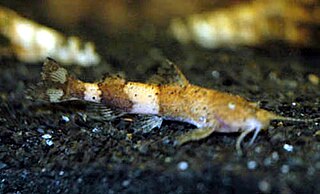 W
WPseudolaguvia is a genus of South Asian river catfishes. These species inhabit hill streams and large rivers. P. tenebricosa is found in fast running, clear water; the river has a sandy bottom and numerous rocks and boulders and aquatic vegetation is absent. P. inornata is from clear, shallow, moderately flowing streams with a predominantly sandy bottom. P. muricata is found in clear, shallow, slow-flowing streams with a mixed substrate of sand and detritus; these fish are found amongst detritus in areas with current. P. ferula is also found in swift flowing waters with a mixed rocky/sandy bottom.
 W
WPuntius is a genus of small freshwater fish in the family Cyprinidae native to South Asia and Mainland Southeast Asia, as well as Taiwan.
 W
WRita is a genus of fish in the family Bagridae found in South Asia. These species have a single pair of mandibular barbels, an elongated Weberian apparatus firmly sutured to the basioccipital and the sensory canal on the posttemporal enclosed with bone.
 W
WRita rita is a species of bagrid catfish that is found across southern Asia. It has been recorded in Afghanistan, Bangladesh, India, Myanmar, Nepal and Pakistan. It is one of the giants of its genus, growing a length of 150 cm. It is commercially fished for human consumption.
 W
WThe longcomb sawfish, narrowsnout sawfish or green sawfish is a species of sawfish in the family Pristidae, found in tropical and subtropical waters of the Indo-West Pacific. It has declined drastically and is now considered a critically endangered species.
 W
WThe shark catfishes form the family Pangasiidae. They are found in fresh and brackish waters across southern Asia, from Pakistan to Borneo. Among the 30-odd members of this family is the plant-eating, endangered Mekong giant catfish Pangasianodon gigas, one of the largest known freshwater fish. Several species are the basis of productive aquaculture industries in Vietnam's Mekong Delta.
 W
WSisor is a genus of catfishes native to Asia.
 W
WSisoridae is a family of catfishes. These Asian catfishes live in fast-moving waters and often have adaptations that allow them to adhere to objects in their habitats. The family includes about 235 species.
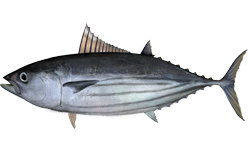 W
WThe skipjack tuna is a medium-sized perciform fish in the tuna family, Scombridae. It is otherwise known as the balaya, tongkol, arctic bonito, mushmouth, oceanic bonito, striped tuna, or victor fish. It grows up to 1 m (3 ft) in length. It is a cosmopolitan pelagic fish found in tropical and warm-temperate waters. It is a very important species for fisheries.
 W
WSperata seenghala, the Giant river-catfish, is a species of bagrid catfish. It is known locally as Guizza, Guizza ayer, Auri, Ari, Pogal, Singhara and Seenghala, among other names. It is found in southern Asia in the countries of Afghanistan, Pakistan, India, Nepal and Bangladesh with reports of occurrence in Thailand and Yunnan, China. It can reach a length of 150 cm, though lengths up to 40 cm are more usual. It is commercially fished for human consumption as well as being a popular gamefish with a reputation for being a good fighter when hooked. It is carnivorous in diet. It can be distinguished from other sperata species by its spatulate, blunt snout, relatively short barbels and mouth that is only 1/3 as wide as the head is long.
 W
WThe starry dragonet is a species of dragonet native to the Indian Ocean where it is found at depths of around 40 metres (130 ft). It occasionally is found in the aquarium trade. It grows to a length of 7.5 centimetres (3.0 in) TL.
 W
WGlossogobius giuris, the tank goby, is a species of goby native to fresh, marine and brackish waters from the Red Sea and East Africa through South Asia and the Indian Ocean to China, Australia and the islands of the Pacific Ocean. This species can also be found in the aquarium trade. It is also known as the bar-eyed goby, flat-headed goby and the Gangetic tank goby.
 W
WThe cleftbelly trevally, also known as the cleftbelly kingfish, Kuweh trevally or thin crevalle, is a species of tropical marine fish of the jack family, Carangidae. The species inhabits coastal waters throughout the Indo-West Pacific region from South Africa in the west to Japan in the east, often found near the water's surface. The cleftbelly trevally is the only member of the genus Atropus and is distinguished by a number of anatomical characteristics, with a deep median groove in the belly giving the species its common name. It is not a large fish, growing to a maximum recorded length of 26.5 cm. Cleftbelly trevally are predatory fish, taking a variety of small crustaceans and fish. The species is of minor importance to fisheries throughout its range.
 W
WTrichogaster fasciata, the banded gourami or striped gourami or giant gourami, is a tropical labyrinth perch found in some Asian countries like Bangladesh, Eastern India, Northeastern India, Nepal, Upper Myanmar, China and Pakistan.